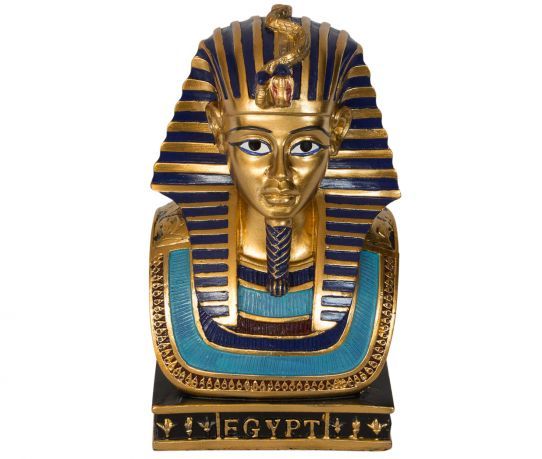We use cookies to make your experience better.
Pharao bust, hand painted (2 types) really beautiful.
- Buy 3 for €13.00 each and save 19%
The word pharaoh ultimately was derived from a compound word represented as pr-3, written with the two biliteral hieroglyphs pr "house" and ꜥꜣ "column". It was used only in larger phrases such as smr pr-aa 'Courtier of the High House', with specific reference to the buildings of the court or palace From the twelfth dynasty onward, the word appears in a wish formula 'Great House, may it live, prosper, and be in health', but again only with reference to the royal palace and not the person.During the reign of Thutmose III (circa 1479–1425 BC) in the New Kingdom, after the foreign rule of the Hyksos during the Second Intermediate Period, pharaoh became the form of address for a person who was king. The earliest instance where pr-aa is used specifically to address the ruler is in a letter to Amenhotep IV (Akhenaten), who reigned circa 1353–1336 BC, which is addressed to 'Pharaoh, all life, prosperity, and health!.[6] During the eighteenth dynasty (16th to 14th centuries BC) the title pharaoh was employed as a reverential designation of the ruler. About the late twenty-first dynasty (10th century BC), however, instead of being used alone as before, it began to be added to the other titles before the ruler's name, and from the twenty-fifth dynasty (eighth to seventh centuries BC) it was, at least in ordinary usage, the only epithet prefixed to the royal appellative. From the nineteenth dynasty onward pr-ꜥꜣ on its own was used as regularly as hm.f, 'Majesty'. The term, therefore, evolved from a word specifically referring to a building to a respectful designation for the ruler, particularly by the twenty-second dynasty and twenty-third dynasty.[citation needed] For instance, the first dated appearance of the title pharaoh being attached to a ruler's name occurs in Year 17 of Siamun on a fragment from the Karnak Priestly Annals. Here, an induction of an individual to the Amun priesthood is dated specifically to the reign of Pharaoh Siamun.This new practice was continued under his successor Psusennes II and the twenty-second dynasty kings. For instance, the Large Dakhla stela is specifically dated to Year 5 of king 'Pharaoh Shoshenk, beloved of Amun' whom all Egyptologists concur was Shoshenq I--the founder of the Twenty-second dynasty--including Alan Gardiner in his original 1933 publication of this stela.Shoshenq I was the second successor of Siamun. Meanwhile, the old custom of referring to the sovereign simply as pr-aa continued in traditional Egyptian narratives.
Pharao
| Dimensions | 180 x 100 x 85mm |
|---|












